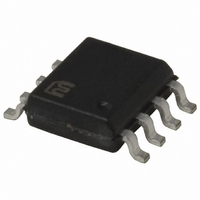MIC2587-1BM TR Micrel Inc, MIC2587-1BM TR Datasheet - Page 9

MIC2587-1BM TR
Manufacturer Part Number
MIC2587-1BM TR
Description
IC CTRLR HOT SWAP POS HV 8-SOIC
Manufacturer
Micrel Inc
Type
Hot-Swap Controllerr
Datasheet
1.MIC2587-2YM.pdf
(16 pages)
Specifications of MIC2587-1BM TR
Applications
General Purpose
Internal Switch(s)
No
Voltage - Supply
10 V ~ 80 V
Operating Temperature
-40°C ~ 85°C
Mounting Type
Surface Mount
Package / Case
8-SOIC (0.154", 3.90mm Width)
Lead Free Status / RoHS Status
Contains lead / RoHS non-compliant
Other names
MIC2587-1BMTR
MIC2587-1BMTR
MIC2587-1BMTR
Functional Description
Hot Swap Insertion
When circuit boards are inserted into systems carrying live
supply voltages ("hot swapped"), high inrush currents often
result due to the charging of bulk capacitance that resides
across the circuit board's supply pins. These current spikes
can cause the system's supply voltages to temporarily go
out of regulation causing data loss or system lock-up. In
more extreme cases, the transients occurring during a hot
swap event may cause permanent damage to connectors
or on-board components.
The MIC2587/MIC2587R is designed to address these
issues by limiting the maximum current that is allowed to
flow during hot swap events. This is achieved by
implementing a constant-current control loop at turn-on. In
addition to inrush current control, the MIC2587 and
MIC2587R incorporate input voltage supervisory functions
and user-programmable overcurrent protection, thereby
providing robust protection for both the system and the
circuit board.
Input Supply Transient Suppression and Filtering
The MIC2587/MIC2587R is guaranteed to withstand
transient voltage spikes up to 100V.
spikes in excess of 100V may cause damage to the
controller.
parasitic inductances, wide (and short) power traces
should be utilized. Alternatively, a heavier trace plating will
help minimize inductive spikes that may arise during
events (e.g., short circuit loads) that can cause a large di/dt
to occur. External surge protection, such as a clamping
diode, is also recommended as an added safeguard for
device (and system) protection. Lastly, a 0.1µF decoupling
capacitor from the VCC pin to ground is recommended to
assist in noise rejection. Place this filter capacitor as close
as possible to the VCC pin of the controller.
Start-Up Cycle
When the power supply voltage to the MIC2587/MIC2587R
is higher than the V
start cycle is initiated. When the controller is enabled, an
internal 16µA current source (I
GATE pin voltage rises from 0V with respect to ground at a
rate equal to:
The internal charge pump has sufficient output drive to fully
enhance commonly available power MOSFETs for the
lowest possible DC losses. The gate drive is guaranteed
to be between 7.5V and 18V over the entire supply voltage
operating range (10V to 80V), so 60V BV
BV
and +24V applications, respectively. However, an external
Micrel
October 2004
DSS
dV
dt
GATE
N-channel power MOSFETs can be used for +48V
=
In order to suppress transients caused by
I
GATEON
C
GATE
UVH
and the V
GATEON
ONH
) is turned on and the
threshold voltages, a
However, voltage
DSS
(1)
and 30V
9
Zener diode (18-V) connected from the source to the gate
as shown in the "Typical Applications" circuit is highly
recommended. A good choice for an 18-V Zener diode in
this application is the MMSZ5248B, available in a small
SOD123 package.
C
R3 minimizes the potential for high-frequency parasitic
oscillations from occurring in M1. However, note that
resistance in this part of the circuit has a slight destabilizing
effect upon the MIC2587/MIC2587R's current regulation
loop.
stabilization of the current regulation loop.
through the power transistor during initial inrush is given
by:
The drain current of the MOSFET is monitored via an
external current sense resistor to ensure that it never
exceeds the programmed threshold, as described in the
"Circuit Breaker Operation" section.
A capacitor connected to the controller’s TIMER pin sets
the value of overcurrent detector delay, t
time for which an overcurrent event must last to signal a
fault condition and to cause an output latch-off. These
devices will be driving a capacitive load in most
applications, so a properly chosen value of C
false-, or nuisance-, tripping at turn-on as well as providing
immunity to noise spikes after the start-up cycle is
complete. The procedure for selecting a value for C
given in the "Circuit Breaker Operation" section.
Overcurrent Protection
The MIC2587 and the MIC2587R use an external, low-
value resistor in series with the drain of the external
MOSFET to measure the current flowing into the load. The
VCC connection (Pin 8) and the SENSE connection (Pin 7)
are the (+) and (-) inputs, respectively, of the device's
internal current sensing circuits. Kelvin sense connections
are strongly recommended for sensing the voltage across
these pins. See the “Applications Information” for further
details.
The nominal current limit is determined by the following
equation.
where V
specified in the datasheet and R
selected sense resistor.
MIC2587R employ a constant-current regulation scheme in
current limit, the charge pump’s output voltage at the
GATE pin is adjusted so that the voltage across the
external sense resistor is held equal to V
capacitor connected to the TIMER pin is being charged. If
GATE
I
I
LIMIT
INRUSH
is used to adjust the GATE voltage slew rate while
Compensation
=
TRIP(TYP)
= C
V
R
TRIP(TYP)
SENSE
LOAD
×
is the typical current limit threshold
I
GATEON
C
GATE
resistor
As the MIC2587 and the
SENSE
R4
MIC2587/MIC2587R
is
is the value of the
FLT
necessary
(408) 955-1690
M9999-102204
, which is the
TRIP
TIMER
The current
while the
(2)
(3)
prevents
TIMER
for
is












